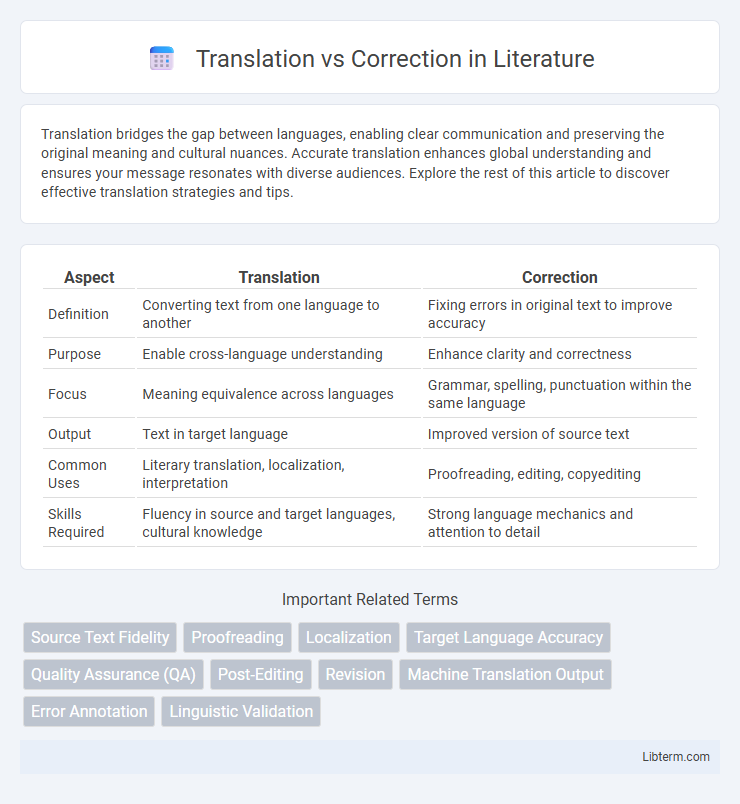Translation bridges the gap between languages, enabling clear communication and preserving the original meaning and cultural nuances. Accurate translation enhances global understanding and ensures your message resonates with diverse audiences. Explore the rest of this article to discover effective translation strategies and tips.
Table of Comparison
| Aspect | Translation | Correction |
|---|---|---|
| Definition | Converting text from one language to another | Fixing errors in original text to improve accuracy |
| Purpose | Enable cross-language understanding | Enhance clarity and correctness |
| Focus | Meaning equivalence across languages | Grammar, spelling, punctuation within the same language |
| Output | Text in target language | Improved version of source text |
| Common Uses | Literary translation, localization, interpretation | Proofreading, editing, copyediting |
| Skills Required | Fluency in source and target languages, cultural knowledge | Strong language mechanics and attention to detail |
Understanding Translation and Correction
Understanding translation involves accurately converting text from one language to another while preserving the original meaning, tone, and context. Correction focuses on identifying and fixing errors in grammar, spelling, punctuation, or style within a text to enhance clarity and coherence. Both processes are essential for effective communication, with translation bridging language gaps and correction ensuring linguistic precision.
Key Differences Between Translation and Correction
Translation involves converting text from one language to another while maintaining meaning, cultural context, and tone, ensuring accurate communication across languages. Correction focuses on identifying and rectifying errors within the same language, such as grammar, spelling, punctuation, and stylistic inconsistencies to improve clarity and readability. Key differences include translation's emphasis on cross-linguistic interpretation versus correction's focus on enhancing the quality and accuracy of a single-language text.
Purposes of Translation and Correction
Translation aims to convert text from one language to another while preserving meaning, cultural context, and tone to facilitate accurate communication across linguistic barriers. Correction focuses on identifying and rectifying errors in grammar, spelling, punctuation, and style within a text to enhance clarity, coherence, and overall quality. The primary purpose of translation is to bridge language gaps, whereas correction ensures the text is polished and error-free for effective understanding.
Skills Required for Each Task
Translation demands strong linguistic proficiency in both source and target languages, alongside cultural understanding to convey meaning accurately. Correction requires keen attention to detail, grammar expertise, and the ability to identify and amend errors without altering the original intent. Both tasks necessitate excellent language skills, but translation emphasizes interpretation and adaptation, while correction focuses on accuracy and consistency.
Process Overview: Translation vs. Correction
Translation involves converting text from one language to another while preserving meaning, context, and tone, requiring linguistic expertise and cultural understanding. Correction, or editing, focuses on reviewing translated content to eliminate errors, improve accuracy, and enhance fluency, ensuring the final output aligns with target language norms. The process overview distinguishes translation as content creation in a new language and correction as quality control to refine and polish that content.
Common Challenges Encountered
Translation and correction both face challenges such as maintaining context accuracy and preserving the original tone. Translators often struggle with cultural nuances and idiomatic expressions, while correctors must identify subtle errors without altering intended meaning. Ensuring consistency across specialized terminology remains a critical issue in both processes.
Impact on Content Accuracy and Quality
Translation transforms content from one language to another, maintaining meaning while adapting cultural nuances, which directly influences content accuracy by ensuring the original intent is preserved. Correction focuses on identifying and rectifying errors within the same language, improving content quality through enhanced grammar, punctuation, and clarity. Both processes are essential in delivering precise, high-quality content, with translation emphasizing semantic fidelity and correction prioritizing linguistic accuracy.
Tools and Technologies Used
Translation employs advanced machine translation tools like Google Translate, DeepL, and neural network-based engines that leverage artificial intelligence and natural language processing to convert text between languages efficiently. Correction utilizes specialized proofreading software such as Grammarly, Hemingway Editor, and LanguageTool, which incorporate grammar-check algorithms, style suggestions, and contextual analysis to enhance text accuracy and readability. Both processes increasingly integrate AI-powered platforms to improve output quality, speed, and scalability in multilingual content management.
When to Choose Translation or Correction
Choosing translation is essential when converting content from one language to another to ensure accurate communication across linguistic boundaries. Correction is preferred when refining existing text to fix errors, improve grammar, or enhance clarity without altering the original language. Opt for translation for multilingual content creation, while correction is suitable for proofreading and editing within the same language.
Industry Applications and Case Studies
Translation in industry applications involves converting content across languages to ensure accurate communication in global markets, with case studies highlighting its role in legal, medical, and technical sectors where precision is critical. Correction, often used in quality assurance, focuses on refining translated materials by eliminating errors and enhancing clarity, essential in fields like pharmaceuticals and finance to maintain regulatory compliance and brand integrity. Both processes contribute to optimized workflows in multinational corporations, improving operational efficiency and customer satisfaction.
Translation Infographic

 libterm.com
libterm.com